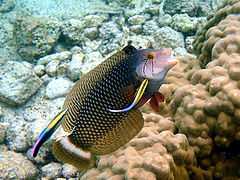Cheating (biology)
Cheating is a metaphor commonly used in behavioral ecology to describe organisms that receive a benefit at the cost of other organisms. Cheating is common in many mutualistic and altruistic relationships.[1] Natural selection favors cheating, but there are mechanisms to regulate cheating.[2]
Theoretical models
The producer/scrounger game contains cheaters. Producers search for their own food while scroungers take the food others have found. Scroungers benefit when producers are common. Producers benefit when scroungers are rare.[3] If there are many scroungers and few producers, the producers are easily able to find food since there is much less competition. If there are few scroungers and many producers, the scroungers can easily cheat. The scroungers are no longer competing against each other to take the producer’s food. A bird can be a scrounger. Instead of foraging for its own food, the scrounger will wait until another bird comes back with food. The next day, the scrounger will follow the successful bird to the patch. The cheating bird reaps the benefits without putting in the effort that the producer put in to find the food.
Animal examples

Examples of animals that are known to cheat include cleaner fish, social insects, ungulates, and birds. Cleaner fish have a mutualistic relationship, a cleaning symbiosis, with their clients in which the cleaners eat ectoparasites from the integument of other fish ("clients"). The clients benefit by being cleaned and the cleaners benefit by acquiring food. However, some cleaners cheat by eating tissue, scales and mucus off their clients rather than only ectoparasites.[4] This could be detrimental to the clients and possibly turn the mutualistic relationship into commensalism or parasitism.[5]
In eusocial insects such as some bees, ants and wasps, the queen is usually the only individual that reproduces. On some occasions, however, cheating workers also reproduce[6] disrupting the altruistic relationship between the queen and the workers.
Vigilance is essential for most animals. When in groups, animals on the periphery will be vigilant, while those within the group forage. The inner animals also monitor the vigilance of the others.[7] A cheater may emerge in groups by continually foraging while the remainder of the group switches between foraging and being vigilant.
Non-animal examples

The relationships between flowering plants and their animal pollinators and plants and fungi are generally mutualistic, but there are cheaters. Two species of yucca moths eat yucca seeds, but do not pollinate the yucca because they lack the necessary mouthparts.[8] The animal pollinators are not the only cheaters though. Some flowers do not produce nectar. Many pollinators are not able to distinguish between which flowers produce nectar and which do not; therefore, some flowers cheat by not making nectar for the pollinator.[9] Examples of nectarless plants include some species of orchids.[10] Orchids are not just cheaters towards pollinators. Some orchids cheat by not providing fixed carbon to mutualistic fungi.[11]
Solutions
There are ways to avoid cheaters, including: policing, changing partners, and pushing the cheater on the outside of a vigilant group. [citation needed]
In order to avoid cheating in polyandrous honeybees, worker policing is enforced, which entails the removal of eggs laid by selfish workers.[12] To prevent cheating cleaner fish, the clients chase them or switch partners.[13]
See also
References
- ↑ Ferriere, R., Bronstein, J.L., Rinaldi, S., Law, R., Gauduchon, M. (2002). "Cheating and the evolutionary stability of mutualisms". Proc. R. Soc. Lond. 269 (1493): 773–780. doi:10.1098/rspb.2001.1900.
- ↑ Foster, K. R., Kokko, H. (2006). "Cheating can stabilize cooperation in mutualisms". Proc. R. Soc. B. 273 (1598): 2233–2239. doi:10.1098/rspb.2006.3571. PMC 1635526. PMID 16901844.
- ↑ Mathot, K. J., Giraldeau, L. (2008). "Increasing vulnerability to predation increases preference for the scrounger foraging tactic". Behav. Ecol. 19 (1): 131–138.
- ↑ Freckleton, R.P., Cote, I.M. (2003). "Honesty and cheating in cleaning symbioses: Evolutionary stable strategies defined by variable pay-offs". Proceedings Royal Society of London 270 (1512): 299–305. doi:10.1098/rspb.2002.2232.
- ↑ Cheney, K. L., Cote, I. M. (2005). "Mutualism or parasitism? The variable outcome of cleaning symbioses". Biology Letters 1 (2): 162–165. doi:10.1098/rsbl.2004.0288. PMC 1626222. PMID 17148155.
- ↑ Oxley, P.R., Thompson, G.J., Oldroyd, B.P. (2008). "Four quantitative trait loci that influence worker sterility in the honeybee (Apis mellifera)". Genetics 179 (3): 1337–1343. doi:10.1534/genetics.108.087270. PMC 2475737. PMID 18562647.
- ↑ Beauchamp, G. (2009). "Sleeping gulls monitor the vigilance behaviour of their neighbours". Biology Letters 5 (1): 9–11. doi:10.1098/rsbl.2008.0490. PMC 2657747. PMID 18940772.
- ↑ Althoff, D. M., Segraves, K. A., Leebens-Mack, J., Pellmyr, O. (2006). "Patterns of Speciation in the Yucca Moths: Parallel Species Radiations within the Tegeticula yuccasella Species Complex". Syst. Biol. 55 (3): 398–410. doi:10.1080/10635150600697325. PMID 16684719.
- ↑ Anand, C., Umranikar, C., Shintre, P., Damle, A., Kale, J., Joshi, J., Watve, M. (2007). "Presence of two types of flowers with respect to nectar sugar in two gregariously flowering species". J. Biosci. 32 (4): 769–774. doi:10.1007/s12038-007-0077-1. PMID 17762150.
- ↑ Thakar, J. D., Kunte, K., Chauhan, A. N., Watve, A. V., Watve, M. G. (2003). "Nectarless flowers: ecological correlates and evolutionary stability". Oecologia 136 (4): 565–570. doi:10.1007/s00442-003-1304-6. PMID 12838401.
- ↑ Taylor, D. L., Bruns, T. D. (1997). "Independent, specialized invasions of ectomycorrhizal mutualism by two nonphotosynthetic orchids". Proc. Natl. Acad. Sci. 94 (9): 4510–4515. doi:10.1073/pnas.94.9.4510. PMC 20753. PMID 9114020.
- ↑ Jordan, L. A., Allsopp, M. H., Oldroyd, B. P., Wossler, T. C., Beekman, M. (2008). "Cheating honeybee workers produce royal offspring". Proc. R. Soc. B. 275 (1632): 345–351. doi:10.1098/rspb.2007.1422. PMC 2593727. PMID 18048282.
- ↑ Bshary, R., Grutter, A. S. (2005). "Punishment and partner switching cause cooperative behaviour in a cleaning mutualism". Biol. Lett. 1 (4): 396–399. doi:10.1098/rsbl.2005.0344. PMC 1626376. PMID 17148216.
| |||||